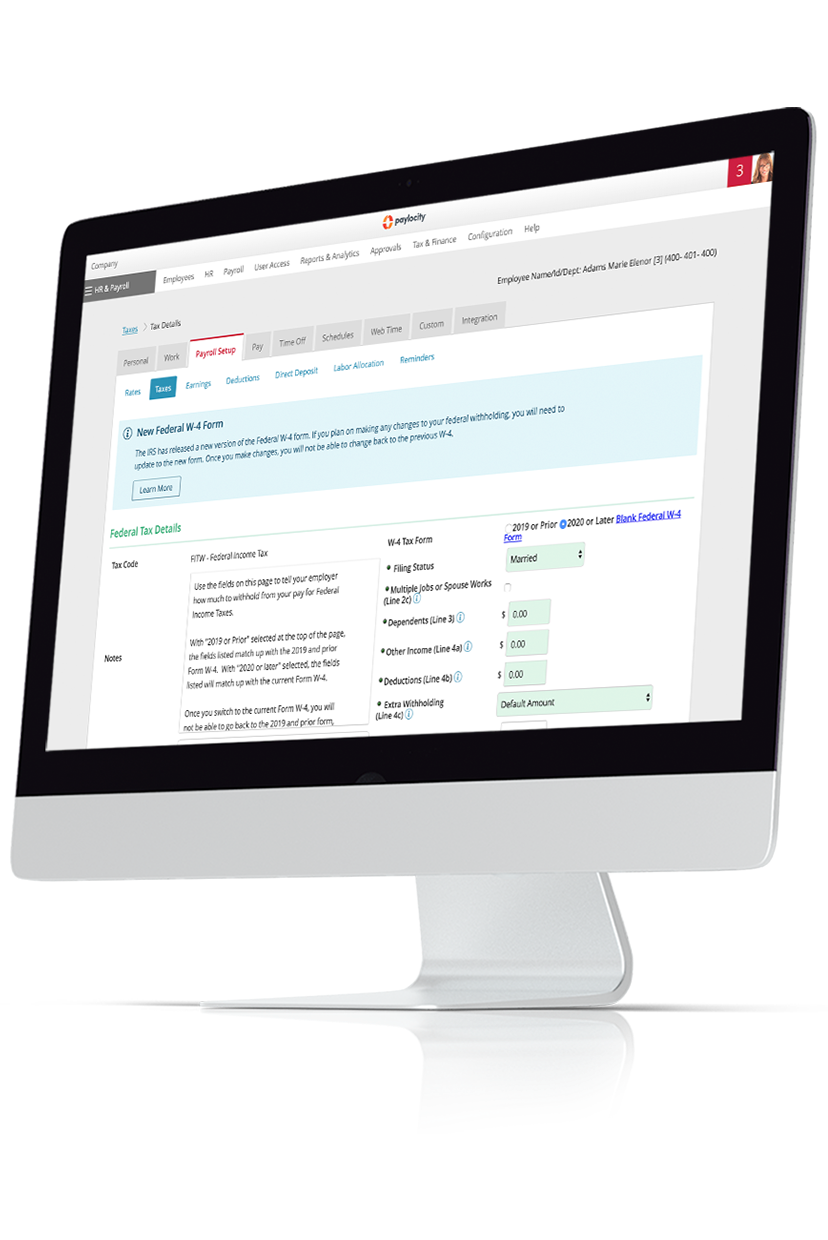Federal Payroll Tax Facts & Frequently Asked Questions
January 21, 2025
Find answers to your U.S. federal payroll tax questions, details on filing statuses, W4s, minimum wage, mileage allowances, HSAs, and more.

What are Payroll Taxes?
Payroll, or employment, taxes are based on the wages and salaries each employee earns. They're paid to federal, state, and local governments to fund government programs and are either a direct contribution from the employer, deducted from employees' paychecks, or split between the two.
What are Examples of Payroll Taxes?
Most payroll taxes exist at the federal and state levels.
- Federal payroll tax: Also known as Federal Insurance Contribution Act (FICA), this tax is split into two parts, one for Medicare and one for Social Security.
- Social Security payroll tax: Split evenly between employer and employees until the employee reaches the wage base of $176,100.
- Medicare payroll tax: Split evenly between employer and employee. If the employee makes more than $200,000 (or $250,000 for married couples filing jointly), they may have to pay an additional 0.9% Medicare tax that the employer doesn't.
- Social Security payroll tax: Split evenly between employer and employees until the employee reaches the wage base of $176,100.
- Unemployment tax: Employers pay federal unemployment tax (FUTA) on the first $7,000 that every employee earns. State unemployment taxes are also paid by employers, however there are a few states where employees also contribute to this tax.
- State and local payroll tax: some areas may have additional payroll taxes for short-term disability, paid sick leave, and other programs.
What are the Differences Between Payroll Tax and Income Tax?
Payroll taxes are a flat rate sent directly to the program for which they help fund such as Social Security, Medicare, and more. Federal income tax is a percentage of total income paid that funds various government projects, such as highway repairs or disaster relief.
Note: This information was last updated January 21, 2025. It is provided as a courtesy, may be updated at any time, and is not intended as legal or tax guidance. The Internal Revenue Service (IRS) establishes and annually adjusts guidelines for federal payroll and income taxes. As such, we recommend seeking the advice of a qualified CPA, tax attorney, or advisor for any questions or concerns.
How is Income Tax Calculated?
The amount of tax withheld depends on two things:
Based on this information, there are two common ways to calculate state and federal income taxes to withhold from employees:
- Percentage Method: Provides a more accurate amount to withhold and will closely match the correct amount.
- Wage-Bracket Method: This has a maximum of ten allowances and limits the wages that can be used to calculate withholding (generally less than $100,000.)
Reference the tables in IRS’s Pub. 15-T, Federal Income Tax Withholding Methods for details.
Why is the Federal W-4 Critical for Tax Withholding Calculations?
New employees will need to fill out a federal W-4 that indicates their filing status, multiple job adjustments, number of deductions, and any additional amounts they wish to withhold from each paycheck.
This will help you determine what will need to be withheld from their paycheck and supplemental wages. You’ll need to keep a signed W-4 for each employee in your records for at least four years.
How Do I Calculate How Much to Withhold for My Employees?
The IRS' Tax Withholding Estimator helps calculate the amount of federal income tax to withhold from employees’ wages. Employees can see how their refund will be affected by the withheld amounts and get an accurate recommendation on how much to voluntarily withhold.
How Do I Withhold Taxes for Supplemental Wages?
Supplemental wages are payments in addition to an employee’s regular paycheck. So, if you provide supplemental wages to your employees, such as a bonus, overtime pay, and any incentive awards or commissions, there will be additional federal income tax due. Supplemental wage taxation for federal income tax can be handled in one of two ways:
- Percentage Method: Withhold a flat percentage (22%) of the supplemental wages
- Aggregate Method: Withhold a specific amount from the combined supplemental and regular wages
The aggregate method can vary depending on how you pay your employees. If you pay their regular wages plus supplemental income in one paycheck, you'd need to withhold the tax the same way you would for their regular paycheck, and you wouldn't need to use the supplemental tax rate.
If the supplemental wages are paid concurrently with regular wages, add the wages together. If you pay an employee their supplemental wages on a separate check, you’ll need to add together their regular wages plus the supplemental wage to find the total taxable income bracket percentage you’ll need to withhold.
What if the Supplemental Wage is More than $1 Million?
If you're issuing a bonus amount of $1 million or less during the year and the amount is identified separately from wages, employers should withhold a flat tax of 22%. Any amount more than $1 million dollars should be taxed at 37% or the highest income tax rate for the tax year.
What are Valid Filing Statuses?
Filing statuses are used to determine the filing requirements, standard deductions, credit eligibility, and correct tax amounts. Here are the filing statuses:
- S = Single
- M = Married
- H = Head of Household
- NRA = Non-Resident Alien
- NRH = Head of Household Non-Resident Alien
- NRM = Married Non-Resident Alien
What are Exemptions and Who is Subject to Exemptions?
An income tax exemption reduces the amount of income or revenue subject to tax, and there are several types of exemption statuses an employee can claim on their Form W-4. However, claimed exemptions are valid for only the calendar year in which the Form W-4 is provided to the employer. In other words, to continually claim the exemption, the employee must re-submit a new Form W-4 claiming the same exemption by February 15 of each year.
- Agricultural labor
- Aliens
- Casual labor
- Combat pay
- Clergy
- Directors of a corporation
- Domestic service
- Family employment
- Federal government employees
- Fishing industry employees
- Foreign government employees
- Hospital patients who are employees
- International organization employees
- Persons serving in the military
- Newspaper carriers and news vendors
- Nonprofit organizations
- Nurses and interns
- Public transportation employees
- Railroad employees
- State and local government employees and students
- U.S. citizens and residents working outside the U.S.
- Persons performing volunteer service
How is Social Security Tax Divided?
Social Security pays monthly benefits to retirees and their families, surviving spouses and children of workers who have died, and people with disabilities and their families.
|
Tax Calculations |
2025 Amount / Rate |
|---|---|
|
Social Security Taxable Wage Base |
$176,100 |
|
Employee Rate |
6.20% |
|
Employer Rate |
6.20% |
|
Maximum Social Security Tax |
$10,918.20 |
What are the Tax Rates for Medicare?
Medicare tax go into a trust fund that pays for some hospital costs and related care expenses of all Medicare beneficiaries.
|
Tax Calculations |
2025 Rate |
|---|---|
|
Medicare Taxable Wage Base |
Unlimited |
|
Employee Rate |
1.45% |
|
Employer Rate |
1.45% |
|
Additional Rate over $200k (MEDHI) |
0.9% |
What are the Tax Rates for Federal Unemployment Insurance?
Employers pay unemployment taxes which covers the costs of administering Unemployment Insurance (UI) and Job Service programs in all states. State Unemployment Insurance (SUI) taxes vary by state and serve the same purpose.
|
Tax Calculations |
2025 Amount / Rate |
|
Unemployment Taxable Wage Base |
$7,000 |
|
Employee Subject to UI Tax? |
No |
|
Unemployment Tax Rates* |
6.0% |
*The Federal Unemployment Tax Act (FUTA) allows a 5.4% credit to employers who file and pay unemployment taxes on time, thus reducing their unemployment tax rate to 0.6%. If, however, the state the employer is in has taken a loan from the federal government to cover state unemployment benefit liabilities and not repaid that loan on time, this credit is reduced by 0.3% every year until the state pays off the loan.
What are the Contribution Limits for Retirement Plans?
The IRS sets limits on how much employers and employees can contribute to pre-tax deferrals so that those who can afford to defer larger amounts of compensation don’t take advantage of tax benefits.
|
Retirement Plan Type Based on Salary |
2025 Compensation Limit |
|---|---|
|
401(a)(17) Compensation Limit |
$350,000 |
|
414(q)(1) Highly Compensated Employees |
$160,000 |
Highly compensated employees have different limits and are identified by two tests: an ownership test and a compensation test. Typically, if the employee owns 5% of the business or is one of the top 20% highest paid employees, making at least $150,000, they're considered highly compensated.
|
Contribution Limits by Plan Type |
2025 Elective Deferrals & Contribution Limits |
|---|---|
|
401(k), 403(b), 408(k) SEP, and 457 |
$23,500 |
|
408(p) SIMPLE |
$16,500 |
|
Catch-Up Contributions |
|
| Super Catch-Up (Ages 60-63) |
|
| SIMPLE IRA / SIMPLE 401(k)* (Higher Deferral Limit) |
$17,600 |
| SIMPLE IRA / SIMPLE 401(k)* (Higher Deferral Catch-Up for Ages 50+) |
$3,850 |
*Note: Under the SECURE 2.0 Act, certain SIMPLE retirement plans have a higher deferral limit (for employees of small employers) or catch-up limit (for employees of smaller employers aged 50 and older).
The basic employee contribution limit for 2025 is $23,500, which includes all elective employee salary deferrals, as well as any after-tax contributions made to a designated Roth account within your 401(k) or a Roth 401(k) plan. However, if you're 50 or older, you can contribute an additional $7,500 as a “catch-up contribution," and those aged 60-63 during the plan year can contribute an additional $11,250 as a "super catch-up contribution."
Employers can also make elective contributions up to a certain amount, regardless of how much or how little employees contribute.
What are Health Savings Account (HSA) Limits?
HSAs can use pre-tax income to cover healthcare costs that insurance doesn’t pay via voluntary deductions from every paycheck.
|
HSA Coverage Type |
2025 Contribution Limit |
|---|---|
|
Self Only Coverage |
$4,300 |
|
Family Coverage |
$8,550 |
|
Catch-Up Contributions (55 or older) |
$1,000 |
What is the Federal Minimum Wage?
|
Wage Type |
Minimum Rate |
|---|---|
|
Minimum Wage Rate |
$7.25 per hour |
|
Tip Minimum Cash Wage |
$2.13 per hour |
|
Actual Tip Credit |
$5.12 per hour |
Learn More: Minimum Wage Guide: 2025 Federal & State Rates
What is Mileage Allowance?
Mileage Allowance rates are used to calculate tax deductions and employee reimbursements when workers use a personal vehicle for business, charitable, medical, or moving purposes. There’s currently no federal requirement for organizations to provide mileage reimbursements, but some states (California, Illinois, and Massachusetts) do have such mandates.
Organizations can choose to reimburse the actual amount an employee incurred on the trip or use a specific rate for each mile the employee drove, usually less than $1 per mile. However, reimbursements and deductions are only applicable to certain qualified transportation expenses, such as visiting a client or attending a business meeting somewhere other than the normal office.

Get Taxes Done Right, Without the Stress
We know there's a lot that goes into preparing and filing payroll tax forms. Save time and get support from our expert team. As a Registered Reporting Agent with the IRS, we can help prepare and file all the necessary forms you need to remain compliant - even in the face of changing legislation. Learn more here.
